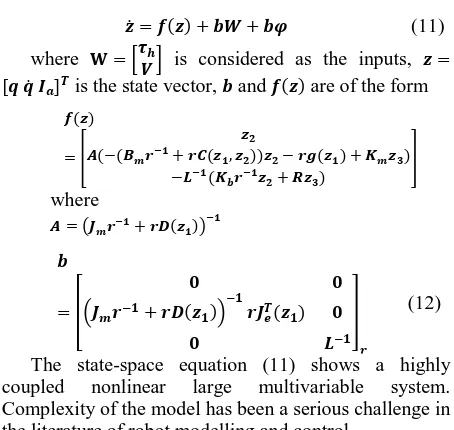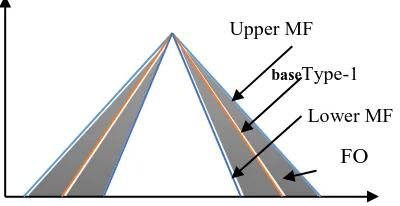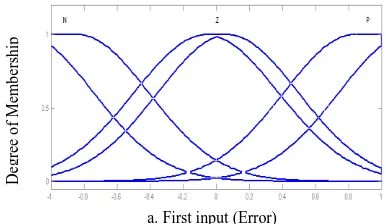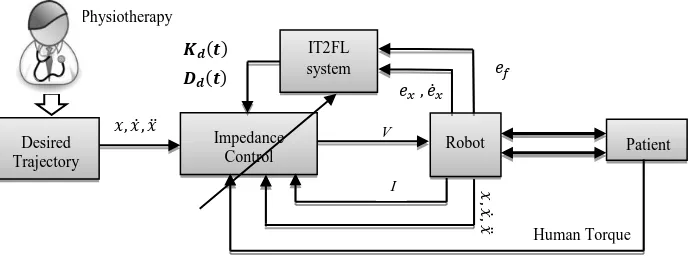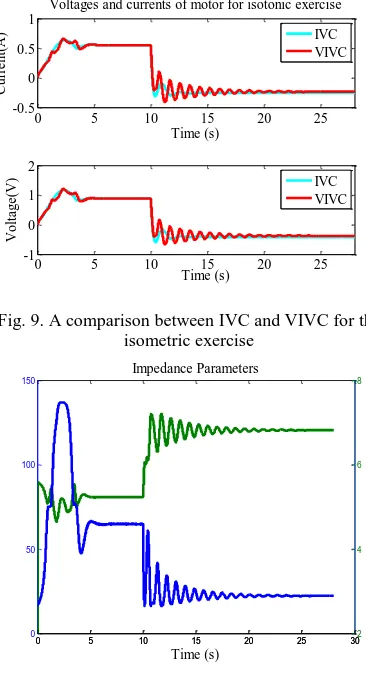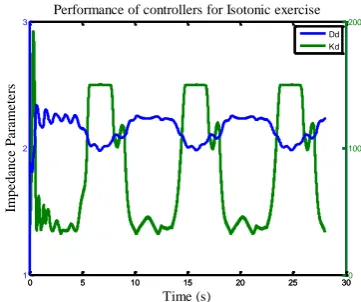*. Corresponding address: Ferdowsi University of Mashhad, Mashhad, Iran,
Tel.: +98 2184063288; fax: +982188674748., E-mail address: ali_akbarzadeh@um.ac.ir.
Variable Impedance Control for Rehabilitation
Robot using Interval Type-2 Fuzzy Logic
V. Khoshdel
a, A. Akbarzadeh
a, *and H. Moeenfard
aa Center of Excellence on Soft Computing and Intelligent Information Processing, Mechanical Engineering Department, Ferdowsi University of Mashhad, Iran
A R T I C L E I N F O A B S T R A C T
Article history: Received: June 18, 2015. Received in revised form: October 17, 2015.
Accepted: October 26, 2015.
In this study, a novel variable impedance control for a lower-limb rehabilitation robotic system using voltage control strategy is presented. The majority of existing control approaches are based on control torque strategy, which require the knowledge of robot dynamics as well as dynamic of patients. This requires the controller to overcome complex problems such as uncertainties and nonlinearities involved in the dynamic of the system, robot and patients. On the other hand, how impedance parameters must be selected is a serious question in control system design for rehabilitation robots. To resolve these problems this paper, presents a variable impedance control based on the voltage control strategy. In contrast to the usual current-based (torque mode) the use of motor dynamics lees to a computationally faster and more realistic voltage-base controller. The most important advantage of the proposed control strategy is that the nonlinear dynamic of rehabilitation robot is handled as an external load, hence the control law is free from robot dynamic and the impedance controller is computationally simpler, faster and more robust with negligible tracking error. Moreover, variable impedance parameters based on Interval Type-2 Fuzzy Logic (IT2Fl) is proposed to evaluate impedance parameters. The proposed control is verified by a stability analysis. To illustrate the effectiveness of the control approach, a 1-DOF lower-limb rehabilitation robot is designed. Voltage-based impedance control are simulated through a therapeutic exercise consist of Isometric and Isotonic exercises. Simulation results show that the proposed voltage-based variable impedance control is superior to voltage-voltage-based impedance control in therapeutic exercises.
Keywords: Impedance control Rehabilitation robot Interval type-2 fuzzy logic Voltage-Based control
1. Introduction
Nowadays, neurological impairments such as Stroke and Cerebral Palsy are the most common forms of disability in adults and children, respectively. People with neurological impairment often have compromised
weakness of the lower limb makes it difficult for the neurologically impaired to practice at the necessary intensity. One-way of providing the required support for the neurologically impaired is to utilize rehabilitation robotic technology to enable practice of useful lower limb movements. The rehabilitation robotics enable the control of the spatial and temporal characteristics of movements [1].
Control is great challenge in rehabilitation robot because the robot is interacting with patients and always a lot of uncertainty is been in this field. Widespread research activities have been performed to control system design of rehabilitation robot in recent years. To perform therapeutic exercises, various control methods such as position control, force control, hybrid position-force control and impedance control have been applied for the rehabilitation robots. Hybrid control and impedance control are two commonly used control methods. The hybrid control was successfully implemented on the LOKOMAT robotic system [2-4]. Compared with other control methods, the impedance control is more effective and flexible to apply a wide range of rehabilitation exercises in the presence of uncertainties [5]. The therapeutic robots such as MIT-MANUS employ impedance control for passive and resistive exercises [6]. An impedance control law is a desired dynamics, which a rehabilitation robot should show in contact with human to perform a commanded therapeutic exercise. Because of applying impedance control, the robotic system will interact with the environment such a mass-spring-damper system in response to the applied force from the environment.
In rehabilitation robot and other case that the environment’s dynamics changing in during task execution has been observed that impedance control with fixed impedance parameters is not effective [7]. Moreover, how impedance parameters must be selected is great question in control system design for rehabilitation robots. Parameters of impedance control are often tuned empirically and intuitively; hence, the system designers have to adjust them according to individuals. Due to this issue, users sometimes have to adapt themselves to the controlled machine when the tuning condition given by the designer is not adequate for the user [8].
To resolve these problems variable impedance has been proposed which impedance parameters adapted according to various characteristics in real time. Impedance parameters have been regulated by some different ways such as varying impedance parameters with fuzzy logic systems [9] adaptive strategies [10] and switching mechanisms [11]. Selsuk et al. proposed impedance control, which gain of mechanical impedance was modified by a fuzzy logic PID controller [12].
G. Xu et al have used fuzzy and fuzzy neural network impedance controller to regulate impedance parameters،. In this studies control method needs to impaired limb parameters for regulate impedance parameters [13, 14]. Also G. Xu et al presented adaptive hierarchical control for upper limb rehabilitation which combines the high-level progressive resistive supervisory controller with a low-level adaptive resistive force triggered controller [15]. Y. Choi et al have proposed a novel robotic adaptive and automatic presentation of tasks. In this study, the high-level adaptive task scheduler regulated task and difficulty of exercise according to physiotherapist, prior practice database and task bank. Then function task model generated desired trajectory for admittance controller [16].
Impedance control is basically defined as a torque control scheme. In the other words, the joint torques of robot are commended to implement impedance control. For this purpose, the controller should overcome complex problems such as uncertainty and nonlinearity involved in the dynamics of the robotic system. Also in torque control scheme, control system design depends on dynamics of patient's limb. Dynamics of patient's limb is nonlinear, unknown and Varies with time. Furthermore, majority of the proposed control approaches have ignored the dynamics of actuators, which are important in motion control and generally this proposed control approaches need to use estimator to estimate patient’s limb parameters [15, 16]. In the torque based control approaches, it is assumed that the actuators can provide the commanded torques for the robot joints. However, this assumption may not be satisfied perfectly due to some practical problems such as the actuator dynamics, actuator saturation and sensing limitations.
In order to overcome nonlinearity of the robotic system and considering the actuators and moreover to create a robot with the ability to adapt to the patient's status in real-time, this paper presents a novel adaptive impedance control for a rehabilitation robot, which can be less dependent on the model of robot dynamics. The impedance parameters are regulated in real-time by IT2FLS according to position error, velocity error and error of force. The proposed control is developed based on the voltage control strategy [17] that differs from the commonly used strategy called, torque control strategy. Compared with a torque control scheme, it is simpler, less computational and more efficient.
performance. Section 6 illustrates the simulation results. Finally, Section 7 concludes the paper.
2. System Dynamics
In general, an electrically driven rehabilitation robot consists of 𝑛 links interconnected at 𝑛 joints into an open kinematic chain. Each link is driven by a permanent magnet dc motor through the gears. We assume that both the links and the couplings between the electric motors and links are perfectly rigid. The dynamic model [9] can thus be described by 𝑛 generalized coordinates representing the degrees-of-freedoms of the 𝑛 joints as
(1)
𝑫𝒓(𝒒)𝒒̈ + 𝑪𝒓(𝒒, 𝒒̇)𝒒̇ + 𝒈𝒓(𝒒) + 𝝉𝒆= 𝝉𝒓
where 𝒒 ∈ 𝑹𝒏 is the vector of joint positions, 𝑫
𝒓(𝒒) ∈
𝑹𝒏 is the matrix of manipulator inertia, 𝑪
𝒓(𝒒, 𝒒̇)𝒒̇ ∈ 𝑹𝒏 is
the vector of centrifugal and Coriolis torques, 𝒈𝒓(𝒒) ∈ 𝑹𝒏 is the vector of gravitational torques, 𝝉
𝒆∈ 𝑹𝒏 is the vector of load torque, and 𝝉𝒓∈ 𝑹𝒏 is the torque vector of robot. Note that vectors and matrices are bold for clarity.
The load torque is actually provided by the human lower limb located on the robot express as
(2)
𝑫𝒆(𝒒)𝒒̈ + 𝑪𝒆(𝒒, 𝒒̇)𝒒̇ + 𝒈𝒆(𝒒) + 𝝉𝒉= 𝝉𝒆
where associated with human body, 𝑫𝒆(𝒒)∈ 𝑹𝒏 is the inertia matrix, 𝑪𝒆(𝒒, 𝒒̇)𝒒̇ ∈ 𝑹𝒏 is the vector of centrifugal and Coriolis torques, 𝒈𝒆(𝒒) ∈ 𝑹𝒏 is the vector of gravitational torques, 𝝉𝒉∈ 𝑹𝒏 is the vector of generated torque by human. Note that vectors and matrices are bold for clarity.
The mechanical section of the rehabilitation robot is obtained by substituting (2) into (1) to obtain
(3)
𝑫(𝒒)𝒒̈ + 𝑪(𝒒, 𝒒̇)𝒒̇ + 𝒈(𝒒) + 𝝉𝒉= 𝝉𝒓
where
𝑫(𝒒) = 𝑫𝒓(𝒒) + 𝑫𝒆(𝒒)
𝑪(𝒒) = 𝑪𝒓(𝒒, 𝒒̇) + 𝑪𝒆(𝒒, 𝒒̇)
𝒈(𝒒) = 𝒈𝒓(𝒒) + 𝒈𝒆(𝒒)
(4)
(5)
(6) The electric motors provide the joint torques of the robot as follows
𝑱𝒎𝒓−𝟏𝒒̈ + 𝑩𝒎𝒓−𝟏𝒒̇ + 𝒓𝝉𝒓= 𝝉𝒎 (7)
where 𝝉𝒎∈ 𝑹𝒏 is the torque vector of motors, 𝑱𝒎, 𝑩𝒎 and 𝒓 are the 𝒏 × 𝒏 diagonal matrices for motor coefficients namely the inertia, damping, and reduction gear, respectively. Vectors of the joint velocities 𝒒̇ and the motor velocities 𝜽̇𝒎∈ 𝑹𝒏 are related through the gears to yield
𝒒̇ = 𝒓𝜽̇𝒎 (8)
In order to obtain the motor voltages as the inputs of system, we consider the electrical equation of geared permanent magnet dc motors in the matrix form,
𝑹𝑰𝒂+ 𝑳𝑰̇𝒂+ 𝑲𝒒̇ + 𝝋 = 𝑽 (9)
where 𝑲 = 𝑲𝒃𝒓−𝟏, 𝑽 ∈ 𝑹𝒏 is the vector of motor voltages, 𝐈𝐚∈ 𝑹𝒏 is the vector of motor currents, and
𝛗 ∈ 𝑹𝒏 is the vector of external disturbances. 𝑹, 𝑳 and
𝑲𝒃 represent the 𝑛 × 𝑛 diagonal matrices for the coefficients of armature resistance, inductance, and back-emf constant, respectively.
The motor torque vector τm as the input for dynamic equation (14) is produced by the motor current vector,
𝛕𝐦= 𝑲𝒎𝑰𝒂 (10)
where 𝐾𝑚 is a diagonal matrix of the torque constants. The state-space model of the electrically driven robot manipulator is introduced by the use of equations (1)-(10) as
𝒛̇ = 𝒇(𝒛) + 𝒃𝑾 + 𝒃𝝋 (11)
where 𝐖 = [𝝉𝑽 ]𝒉 is considered as the inputs, 𝒛 =
[𝒒 𝒒̇ 𝑰𝒂]𝑻 is the state vector, 𝒃 and 𝒇(𝒛) are of the form
𝒇(𝒛)
= [
𝒛𝟐
𝑨(−(𝑩𝒎𝒓−𝟏+ 𝒓𝑪(𝒛
𝟏, 𝒛𝟐))𝒛𝟐− 𝒓𝒈(𝒛𝟏) + 𝑲𝒎𝒛𝟑)
−𝑳−𝟏(𝑲
𝒃𝒓−𝟏𝒛𝟐+ 𝑹𝒛𝟑)
]
where
𝑨 = (𝑱𝒎𝒓−𝟏+ 𝒓𝑫(𝒛𝟏)) −𝟏
(12) 𝒃
= [
𝟎 𝟎
(𝑱𝒎𝒓−𝟏+ 𝒓𝑫(𝒛𝟏))
−𝟏
𝒓𝑱𝒆𝑻(𝒛𝟏) 𝟎
𝟎 𝑳−𝟏
]
𝒓
The state-space equation (11) shows a highly coupled nonlinear large multivariable system. Complexity of the model has been a serious challenge in the literature of robot modelling and control.
Fig. 1. A schematic of rehabilitation robot
It can be obtained by using (9) and (12) that
(13)
𝑹𝑰𝒂+ 𝑳𝑰̇𝒂+ 𝑲𝒒̇ = 𝑽
3. Interval Type-2 Fuzzy Logic Systems
A fuzzy logic system that uses at least one type-2 fuzzy set is called a type-2 fuzzy logic system. It is very useful in circumstances, where the determination of an exact membership grade for a fuzzy set is difficult [18]. As illustrated in Fig. 2, a type-2 fuzzy MF can be obtained by starting with a type-1 MF and blurring it. The extra mathematical dimension provided by the blurred area represents the uncertainties in the shape and
position of the type-1 fuzzy set and is referred to as the footprint of uncertainty (FOU).
The FOU is bounded by upper and lower MFs, and points within the "blurred area" have membership grades given by type-1 MFs. The most frequently used type-2 fuzzy sets are interval fuzzy sets, where each point in the FOU has unity secondary membership grade [19].
An interval type-2 fuzzy set
A
inX
is defined as [20]𝑨
̃ =∫ [∫
𝟏 𝒖 𝒙∈𝑱𝒙 ] 𝒙∈𝑿
𝒙 , 𝑱𝒙⊆ [𝟎 − 𝟏] (14)
where 𝑥 is the primary variable with domain 𝑋, 𝑢 the secondary variable which has domain 𝐽𝑥, 𝐽𝑥 is called the primary membership of 𝑥. Uncertainty about 𝐴̃ is conveyed by
the union of all the primary memberships called the footprint of uncertainty (FOU) of 𝐴̃, i.e., [21]
𝐹𝑂𝑈(𝐴̃) = 𝐽𝑥 , 𝑥 ∈ 𝑋 (15)
The structure of a typical type-2 fuzzy logic system is shown in Fig. 3. It is similar to its type-1 counterpart. The major difference is that at least one of the fuzzy sets is type-2 and a type-reducer is needed to convert the type-2 fuzzy output sets into type-1 sets so that they can be processed by the defuzzifire to give a crisp output [18]. General type-2 fuzzy logic systems (FLSs) are computationally intensive because type-reduction is very intensive [18, 22].
Fig. 2. Type-2 fuzzy logic membership function
Therefore, we will use in this work the interval type-2 fuzzy logic systems for their simplicity and efficiency. We design the fuzzy systems by the use of two inputs. If we select three fuzzy sets for each input, the whole control space will be covered by 9 fuzzy rules. The fuzzy rules are of the form of
𝑅𝑖 : if 𝑥
1 is 𝑋̃1𝑖 and 𝑥2 is 𝑋̃2𝑖 then 𝑦𝑖= 𝑎𝑖1𝑥1+ 𝑎𝑖2𝑥2+ 𝑎𝑖0
𝑖 = 1,2, … , 𝑚 (16)
where 𝑋̃𝑗𝑖(𝑗 = 1,2) is an interval type-2 fuzzy set and the inputs of rule 𝑅𝑖 is 𝑥 = (𝑥1, 𝑥2) ∈ 𝑈 ∈ 𝑹2, 𝑈 is the universe of discourse. M is the number of rules, and in the i-th rule (𝑅𝑖), 𝑎𝑖1and 𝑎𝑖2 are the gains in
consequent part for 𝑖 = 1, 2, 𝑦𝑖 is the crisp output. The proposed interval type-2 fuzzy system is for the case when antecedents are interval type-2 fuzzy sets (A2) and consequents are crisp numbers (C0) [23]. The inference engine combines all the ring rules and gives a nonlinear mapping from the input interval type-2 fuzzy sets to the output interval type-2 fuzzy sets.
The firing strength set of the i-th rule is [22]
𝐹𝑖(𝑥) = [𝑓𝑖(𝑥), 𝑓̅𝑖(𝑥)] =
[𝑓𝑖, 𝑓̅𝑖] (17)
where
𝑓𝑖= 𝜇
𝑋̃1𝑖(𝑥1)× 𝜇𝑋̃2𝑖(𝑥2) (18) 𝑓̅𝑖= 𝜇̅
𝑋̃1𝑖(𝑥1)× 𝜇̅𝑋̃2𝑖(𝑥2) (19) The terms μX̅ji(j=1,2)and μ̅X̅ji(j=1,2) are the lower and upper membership grades of μX̅ji, respectively. The type-2 fuzzy inference engine produces an aggregated output type-2 fuzzy set. The type reduction block operates on this set to generate a centroid type-1 fuzzy set known as the type-reduced set " of the aggregate type-2 fuzzy set. Several type-reduction methods have been suggested in the literature, such as the center-of-sums, the height, the modified height and the center-of-sets [18; 22]. The most commonly used one is the center-of-sets type-reducer due to its computational efficiency. That may be expressed as [18, 22]
Fig.3. Scheme of a type-2 fuzzy logic system
𝑌𝑐𝑜𝑠(𝑥) = [𝑦𝑙, 𝑦𝑟] = ⋃
∑𝑀 𝑓𝑖𝑦𝑖 𝑖=1 ∑𝑀 𝑓𝑖
𝑖=1 𝑓𝑖∈𝐹𝑖(𝑥)
(20)
where 𝑌𝑐𝑜𝑠 is the interval set determined by two end points 𝑦𝑙 and 𝑦𝑟, and firing strengths 𝑓𝑖= [𝑓𝑖, 𝑓̅𝑖] ∈ 𝐹𝑖(𝑥). 𝑦
𝑙 and 𝑦𝑟can be expressed as
𝑦𝑙=
∑ 𝑓̅𝑖𝑦𝑖+∑𝑀 𝑓𝑖𝑦𝑖
𝑖=𝐿+1 𝐿
𝑖=1
∑ 𝑓̅𝑖+∑𝑀 𝑓𝑖
𝑖=𝐿+1 𝐿
𝑖=1
(21)
𝑦𝑟=∑ 𝑓
𝑖𝑦𝑖+∑𝑀 𝑓̅𝑖𝑦𝑖 𝑖=𝑅+1 𝑅
𝑖=1
∑ 𝑓𝑖+∑𝑀 𝑓̅𝑖
𝑖=𝑅+1 𝑅
𝑖=1
(22)
Two end points 𝑦𝑙 and 𝑦𝑟can be computed efficiently using the Karnik-Mendel (KM) algorithms [22]. Since
Fuzzifier
Rule Crisp
Input
Type-2 fuzzy input
set
Crisp output
Type-1 fuzzy set
Type reducer Inference
Defuzzifier
baseType-1 MF Upper MF
Lower MF
the type- reduced set is an interval type-1 set, the defuzzifire output is [18]
𝑦(𝑥) = 0.5(𝑦𝑙+ 𝑦𝑟) (23)
4. Control strategy
An impedance rule is proposed as
(24)
𝑫𝒅(𝒕)(𝒒𝒅̇ − 𝒒̇) + 𝑲𝒅(𝒕)(𝒒𝒅− 𝒒) = 𝝉𝒉
where 𝑫𝒅(𝒕) and 𝑲𝒅(𝒕) are the diagonal matrices, which include the desired impedance parameters that regulate by IT2FL systems. From (24), we have
(25)
𝒒𝒅̇ + 𝑫𝒅−𝟏(𝒕)𝑲𝒅(𝒕)(𝒒𝒅− 𝒒) + 𝑫𝒅−𝟏(𝒕)𝝉𝒉
= 𝒒̇
An impedance controller which establishes the impedance rule (14) is proposed as
(26)
𝑹𝑰𝒂+ 𝑳𝑰̇𝒂+ 𝑲(𝒒𝒅̇ + 𝑫𝒅−𝟏𝑲𝒅(𝒕)(𝒒𝒅− 𝒒)
+𝑫𝒅−𝟏(𝒕)𝝉𝒉) = 𝑽
The closed loop system is formed by substituting the control law (16) into the system (9) as
𝑹𝑰𝒂+ 𝑳𝑰̇𝒂+ 𝑲(𝒒𝒅̇ + 𝑫𝒅−𝟏(𝒕)𝑲𝒅(𝒕)(𝒒𝒅
− 𝒒) + 𝑫𝒅−𝟏(𝒕) 𝝉𝒉)
= 𝑹𝑰𝒂+ 𝑳𝑰̇𝒂+ 𝑲𝒒̇
(27)
We design IT2FL system to determined impedance parameters adaptively, we consider the 𝑿𝟏𝑲= 𝑭𝒅− 𝑭𝒉 and 𝑿𝟐𝑲= 𝒆 as inputs. Where 𝑒 is a position error and defined as 𝒆 = 𝑿𝒅− 𝑿. The IT2FL takes these two inputs and provides an impedance parametersKd.
The membership functions of an IT2FL can be assumed as triangular functions, trapezoidal functions, Gaussian functions, etc [24]. In this study, Gaussian functions are used. The membership functions for 𝑲𝒅 and 𝑫𝒅are shown in Figure 4 and Figure 5, respectively. Note that "N" stands for negative, "E" stands for 0, and "P" stands for positive. All the universes of discourses are normalized and arranged in [-1 1] for inputs. The rules of the fuzzy systems are given in Section table 2 and 3.
a. First input (Error)
b. second input (Derivate Error) Fig. 4. Membership function of the type-2 FLS for Kd
a. First input (Error)
b. second input (Derivate Error) Fig. 5. Membership function of the type-2 FLS for Dd
Table 1 : Fuzzy Rules ( 𝑫𝒅(𝒕)) 𝑫𝒅(𝒕) Second input N Z 𝑿𝟐𝑫= 𝑿̇𝒅− 𝑿̇P First input
𝑿𝟏𝑫= 𝑭𝒅− 𝑭𝒉
N 2 4 6
Z 4 6 8
P 6 8 10
Table 2. Fuzzy Rules ( 𝑲𝒅(𝒕))
𝒌𝒅(𝒕) Second input (N Z 𝑿𝟐𝑲= 𝑿𝒅− 𝑿P ) First input
𝑿𝟏𝑲= 𝑭𝒅− 𝑭𝒉
N 50 70 90
Z 70 90 110
P 90 110 130
5. Stability Analysis
A proof for the boundedness of state variables is given by stability analysis. In order to analyze the stability, the following assumptions are made:
D
eg
re
e
o
f
M
em
b
er
sh
ip
D
eg
re
e
o
f
M
em
b
er
sh
ip
D
eg
re
e
o
f
M
em
b
er
sh
ip
D
eg
re
e
o
f
M
em
b
er
sh
𝑫𝒅(𝒕)(𝒒𝒅̇ − 𝒒̇) + 𝑲𝒅(𝒒𝒅− 𝒒) = 𝝉𝒉 (28)
Assumption 1 The desired trajectory in the joint-space 𝐪𝐝 must be smooth in the sense that 𝒒𝒅 and its derivatives up to a necessary order are available and all uniformly bounded [22]. Equation (28) shows a linear second order system with a bounded input𝝉𝒉. In (28) the suggested matrices 𝑫𝒅(𝒕) and 𝑲𝒅(𝒕) are positive diagonal matrices. Therefore, the linear system (28) is stable based on the Ruth-Hurwitz criteria. Because the input 𝝉𝒉 is bounded as a consequence
Result 1:𝒒𝒅− 𝒒 and 𝒒𝒅̇ − 𝒒̇ are bounded.
In addition, Assumption 1 states that 𝒒𝒅 and 𝒒𝒅̇ are bounded. Thus, using Assumption 1 and Result 1 yields to
Result 3: The variables 𝒒 and 𝒒̇ are bounded. In (3), the boundedness of𝒒, 𝒒̇and 𝝉𝒉yields to Result 4: The joint torque vector𝝉𝒓 is bounded. In (7), vectors of 𝒒̇, 𝒒̈ and 𝝉𝒓 are bounded and matrices𝐽𝑚, 𝐵𝑚 and 𝑟 are constant. Thus,
Result 5: The motor torque vector 𝝉𝒎 is bounded. From (10), it can be written that 𝑰𝒂= 𝑲𝒎−𝟏 𝝉𝒎. 𝐾𝑚 is a constant matrix and 𝝉𝒎 is bounded in Result 5. Therefore,
Result 6: The motor current vector 𝑰𝒂 is bounded. The robotic system is stable since all system states 𝒒, 𝒒̇ and 𝑰𝒂 are bounded.
6. Simulation Results
In this study, the Impedance Voltage Control with constant impedance parameters (IVC) [10] is compared with proposed Variable Impedance Control using IT2FL system based on Voltage Control (VIVC), which has been shown in Figure 6.
The rehabilitation robotic system is a single link robot driven by a permanent magnet dc motor as shown in Figure 1. Parameters of rehabilitation robotic system and the patient are given in Table 3, where 𝑚𝑟 is the mass of link, 𝑚ℎ is the mass of patient’s leg, 𝑙𝑟 is the length of link, 𝑙𝑝 is the length of patient’s leg, and 𝑟𝑐= [𝑥𝑐, 𝑦𝑐, 𝑧𝑐] is the center of mass for the link. The inertia tensor in the center of mass is expressed as
𝐼 = (
𝐼𝑥𝑥 𝐼𝑥𝑦 𝐼𝑥𝑧
𝐼𝑦𝑥 𝐼𝑦𝑦 𝐼𝑦𝑧
𝐼𝑧𝑥 𝐼𝑧𝑦 𝐼𝑧𝑧
) (29)
Parameters of the motor are given in Table 4. For the tracking control, the desired trajectory should be sufficiently smooth such that all its derivatives up to the required order are bounded.
In addition, tracking the desired trajectory in the given exercise should be suitable for the patient. The desired trajectory for isotonic exercises starts from zero and goes up to 80° for the extension and stays this position for several seconds.
Table 3. Parameters of Manipulator and Patient
𝐼𝑦𝑧 𝐼𝑧𝑥 𝐼𝑧𝑦 𝐼𝑧𝑧 𝑚𝑟 𝑚ℎ 𝑙ℎ 𝑙𝑟
0 0 0 0.91 2 4 0.5 0.5
𝑥𝑐 𝑦𝑐 𝑧𝑐 𝐼𝑥𝑥 𝐼𝑥𝑦 𝐼𝑥𝑧 𝐼𝑦𝑥 𝐼𝑦𝑦
0.09 -0.16 0 0.91 -0.12 0 -0.12 0.23 Table 4. The Electric Motor Parameters
𝑉𝑚𝑎𝑥 𝑅 𝐾𝑏 𝐿 𝐽𝑚 𝐵𝑚 𝑟
40 1.6 0.26 0.001 0.0002 0.001 0.02
Fig. 6. Block diagram of the proposed control scheme
𝑒𝑥 , 𝑒̇𝑥
Impedance
Control Robot Patient
𝑥,
𝑥̇,
𝑥̈ Human Torque V
𝑥, 𝑥̇, 𝑥̈
IT2FL system
𝑲𝒅(𝒕)
𝑫𝒅(𝒕)
Physiotherapy
Desired Trajectory
𝑒𝑓
6.1. Isometric exercise
The aim of this exercise is that the specified resistance force applied to the patient while the limb angle not change. The force is determined individually for each patient by physiotherapist. In this type of exercise limb move to the desired angle, without applied any resistance force to the patient, after that the desired force applied to the patient and he or she try to not be changed the angle of limb.
Simulation results show a comparison between the proposed IVC and VIVC in Figure 7. The IVC tracks the desired trajectory very well until that in specified time desired force must be applied to the patients. In this time, constant potion error is created which according to control impedance theory is predictable. With cursory glance at the graph, we can clearly state that in comparison with IVC, the proposed adaptive impedance voltage control has less position error. The impedance control can be evaluated according to how well the impedance law is performed. For this purpose, the force that applied to the patient is shown in Figure 8. The IVC and VIVC have similar results in impedance that applied to the patient. The IVC and VIVC shows a force error with a maximum value of 1.6 𝑁 and 1.4 𝑁 respectively.
Fig. 7. A comparison between the IVC and the VIVC for the isometric exercise
Fig. 8. A comparison between IVC and VIVC for isometric exercise
Fig. 9. A comparison between IVC and VIVC for the isometric exercise
Fig. 10. Impedance parameters tuned by the IT2FLS In control methods with using voltage control strategy the motor voltage and motor currents of controllers must be in valid range without suddenly changed. For isometric exercise they are shown in Figure 9, respectively. Adaptive Impedance parameters for the VIVC method has been shown in Figure 10.
6.2. Isotonic exercise
Isotonic exercise is one method of muscular exercise where a constant resistance force is applied to the patient for duration of the movement. In contrast, in the isometric exercise the muscular contractions occur without movement of the involved parts of the body. In this study, the Impedance Voltage Control (IVC) expressed by (20) with constant impedance parameters of 𝑫𝒅(𝒕) and 𝑲𝒅(𝒕) is simulated and compared with the proposed VIVC with the variable impedance parameters.
Simulation results, shown in Figure 11, compares the proposed VIVC and the IVC. The IVC and the VIVC have the same efficient with respect to tracking trajectory. Additionally, the impedance control should be evaluated according to how well the impedance law is performed. The force applied to the patient is shown in Figure 12. The art of proposed control has been shown in the force applied to the patient. The IVC results in a force error with a maximum value of 4.1 N
0 5 10 15 20 25
0 10 20 30 40 50 60 70 80 90
Time (s)
P
os
it
ion
(de
gr
e
e
)
Performance of controllers for Isotonic exercise
Desired IVC VIVC
0 5 10 15 20 25
-2 0 2 4 6 8 10 12
Time (s)
F
or
c
e
(
N
)
Performance of controllers for Isometric exercise
IVC VIVC Desired
0 5 10 15 20 25
-0.5 0 0.5 1
Time (s)
C
ur
re
nt
(A
)
Voltages and currents of motor for isotonic exercise
0 5 10 15 20 25
-1 0 1 2
Time (s)
V
ol
ta
ge
(V
)
IVC VIVC
IVC VIVC
0 5 10 15 20 25 30
0 50 100 150
Time (s) Impedance Parameters
0 5 10 15 20 25 302
while the proposed VIVC shows a significantly lower force error of 2.2 N.
The motor voltage and motor current of robot for isotonic exercise are shown in Figure 13. As shown in this figure, they perform well without oscillations under the permitted values. The Adaptive Impedance parameters for the AIVC method is shown in Figure 14. As shown, these parameters are fluctuated according to the isotonic exercise, while remaining in a valid range.
Fig. 11. A comparison between the IVC and the VIVC for isotonic exercise
Fig. 12. A comparison between the IVC and the VIVC for isotonic exercise
Fig. 13. A comparison between IVC and VIVC for isotonic exercise
Fig. 14. Impedance parameters tuned by IT2FLS
7. Conclusion
Impedance control is an effective method in controlling the rehabilitation robots. The therapeutic exercises are performed well with satisfactory performances. The previous impedance control approaches were developed based on the torque control strategy whereas the proposed impedance control is based on the voltage control strategy. The proposed approach is free of manipulator dynamics, thus is simpler, less computational, and more effective compared with the torque based control approaches. Additionally, since it is difficult to be sure about the ideal value of the impedance parameters, interval type-2 fuzzy logic systems are used to regulate impedance parameters. The proposed technique for applying the adaptive impedance parameters is shown to be more efficient than using the constant impedance parameters. The control approach has been verified by stability analysis. The simulation results show the superiority of the proposed control approach over a constant impedance control scheme.
References
[1] E. Akdogan and M. Arif Adli. “The design and control of a therapeutic exercise robot for lower limb rehabilitation: Physiotherabot”, Mechatronics, Vol. 21, (2011), pp. 509–522. [2] M. S. Ju, C. C. K. Lin, D. H. Lin, I. S. Hwang and S. M. Chen,
“A rehabilitation robot with force-position hybrid fuzzy controller: Hybrid fuzzy control of rehabilitation robot”, IEEE
Transactions on Neural Systems and Rehabilitation
Engineering, Vol. 13(3), (2005), pp. 349–358.
[3] PA. Houglum, “Therapeutic exercises for musculoskeletal injuries”, ThomsonShore, 2009.
[4] M. Bernhardt, M. Frey, G. Colombo, and R. Riener,“Hybrid force-position control yields cooperative behaviour of the rehabilitation robot LOKOMAT”, In 9th International Conference on Rehabilitation Robotics, ICORR2005, (2005), pp. 536–539.
[5] H. I. Krebs, N. Hogan, M. L. Aisen, and B. T. Volpe, “Robot aided neurorehabilitation”, IEEE Transactions on Rehabilitation
Engineering, 6(1), (1998), pp. 75–87.
0 5 10 15 20 25
-20 0 20 40 60 80
Time (s)
P
os
it
ion
(D
e
gr
e
e
)
Performance of controllers for Isotonic exercise
Desierd IVC VIVC
0 5 10 15 20 25
0 2 4 6 8 10 12
Time (s)
F
or
c
e
(
N
)
Performance of controllers for Isotonic exercise
IVC VIVC Desired
0 5 10 15 20 25
-1.5 -1 -0.5 0 0.5
Time (s)
C
ur
re
nt
(A
)
Voltages and currents of motor for isotonic exercise
0 5 10 15 20 25
-2 -1 0 1
Time (s)
V
ol
ta
ge
(V
) IVC
VIVC IVC VIVC
0 5 10 15 20 25 30
1 2 3
Time (s)
Im
pe
da
nc
e
P
a
ra
m
e
te
rs
Performance of controllers for Isotonic exercise
0 5 10 15 20 25 300
100 200
[6] R. Richardson, M. Brown, M. Bhakta and M. C. Levesley, “Design and control of a three degree of freedom pneumatic physiotherapy robot”. Robotica, 21, (2003), pp. 589–604. [7] T. Tsuji, and Y. Tanaka, “On-line learning of robot arm
impedance using neural networks” Robot. Auton. Syst. Vol. 52, (2005), pp. 257–271.
[8] T. Tsuji and Y. Tanaka, “Tracking control properties of human-robotic systems based on impedance control”, IEEE Trans. Syst.
Man Cybern., Vol. 35, (2005), pp. 523–535.
[9] C. Yueyan, Z. Ji, W. Bidou and H. Shuang, “High-Precision Fuzzy Impedance Control Algorithm and Application in Robotic Arm”, International Conference on Advanced Intelligent Mechatronic Monterey, Colifornia, USA, (2005), pp. 24-28.
[10] M. M Fateh and V. Khoshdel, “Voltage-Based Adaptive Impedance Force Control for a Lower-Limb Rehabilitation Robot”, Advanced Robotic, Vol. 12, (2015), pp. 1-15.
[11] R. Z. Stanisic and A. V. Fernandez, “Adjusting the Parameters of the mechanical impedance for Velocity, impact and force control”, Robotica, Vol. 30, (2012), pp. 583-597.
[12] S. Kizir and Z. bingul, “Fuzzy Impedance and Force Control of Stewart Platform”, Journal of Electrical Engineering &
Computer Sciences, (2013).
[13] G. Xu, A. Song and H. Li, “Control System Design for an Upper-Limb Rehabilitation Robot”, Advanced Robotics, Vol. 25, pp. 229-251.
[14] G. Xu, A. Song and H. Li, “Adaptive Impedance Control for Upper-Limb Rehabilitation Robot Using Evolutionary Dynamic Recurrent Fuzzy Neural Network”, Journal of Intelligent Robot
System, Vol. 62, (2011), pp. 501–525.
[15] L. Huanga, S. S. Geb and T. H. Leeb, “Fuzzy unidirectional force control of constrained robotic manipulators”, Fuzzy Sets
and Systems, Vol. (134), (2003), pp. 135–146.
[16] D. Surdilovic and Z. Cojbasic, “Robust Robot Compliant Motion Control Using Intelligent Adaptive Impedance Approach”, International Conference on Robotics & Automation Detroit, Michigan, May 1999.
[17] M. M. Fateh, “On the voltage-based control of robot manipulators”, International Journal of Control, Automation,
and Systems, Vol. 6(5), (2008), pp. 702–712.
[18] J. M. Mendel. “Uncertain Rule-based Fuzzy Logic Systems: Introduction and New Directions”, Upper Saddle River, N. J: Prentice-Hall, 2001.
[19] H. A. Hagras, “A hierarchical type-2 fuzzy logic control architecture for autonomous mobile Robots”, IEEE Transactions on Fuzzy Systems, Vol. 12(4), (2004), pp. 524-539.
[20] L. A. Zadeh, “The concept of a linguistic variable and its application to approximate reasoning”, Information Sciences, Vol. 8(3), (1975), pp. 199-249.
[21] V. Khoshdel and A. Akbarzadeh, “Robust Impedance Control for Rehabilitation Robot”, Modares Mechanical Engineering Vol.15(8), (2015), pp.429-437 (In Persian).
[22] Q. L. Liang and J. M. Mendel, “Interval type-2 fuzzy logic systems: Theory and design”, IEEE Transactions on Fuzzy
Systems, Vol. 8(5), (2000), pp. 535-550.
[23] M. Biglarbegian, W. W. Melek and J. M. Mendel, “On the stability of interval type-2 TSK fuzzy logic control systems”, IEEE Transactions on Systems, Man, and Cybernetics Part B:
Cybernetics, Vol. 40(3), (2010), pp. 798-818.
[24] L. X. Wang, “A Course in Fuzzy Systems and Control”, NewYork: Prentice Hall, (1996).
Biography
Vahab Khoshdel is member of Center of Excellence on Soft Computing and Intelligent Information Processing (SCIIP) in Ferdowsi University of Mashhad. He received his BSc., MSc. degrees in Robotic and Mechatronic engineering from University of Shahrood in 2011, 2013, respectively. His main research interests include robotics (rehabilitation robots and biomedical robots), intelligent control and mechatronic.
Alireza Akbarzadeh
received his PhD in
Mechanical Engineering in 1997 from the University of New Mexico in USA. He worked at Motorola, USA, for 15 years where he led R&D as well as automation teams. He joined the Ferdowsi University of Mashhad in 2005 and is currently professor in the Mechanical Engineering Department. His areas of research include robotics (parallel robots, biologically inspired robots, bipedal robots, and rehabilitation robotics), dynamics, kinematics, control, automation, optimization as well as design and analysis of experiments. He is also a founding member of the Center of Excellence on Soft Computing and Intelligent Information Processing (SCIIP).
Hamid Moeenfard receives
his master degree in
Mechanical Engineering
from Sharif University of Technology, Tehran, Iran, 2008. He also received his
PhD in Mechanical
